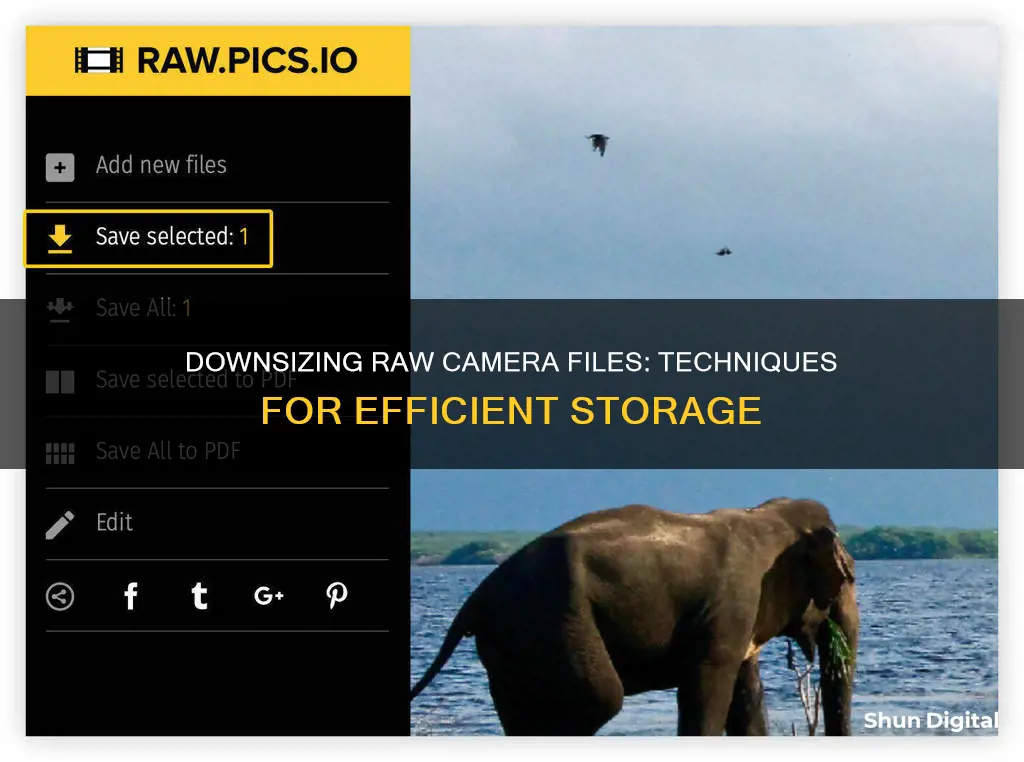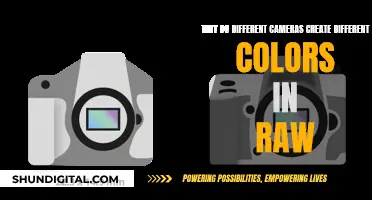
A camera raw image file contains unprocessed or minimally processed data from the image sensor of a digital camera. Raw files are so named because they are not yet processed and contain large amounts of potentially redundant data. They are sometimes incorrectly described as digital negatives.
Raw image formats are intended to capture the radiometric characteristics of a scene—that is, physical information about the light intensity and colour of the scene, at the best of the camera sensor's performance.
To shoot camera raw images, you must set your camera to save files in its own camera raw file format.
The Photoshop Raw format (.raw) is a file format for transferring images between applications and computer platforms. Don’t confuse Photoshop raw with camera raw file formats. File extensions for camera raw files vary depending on the camera manufacturer.
You can't resize raw files per se. You can, however, crop them in a raw editor like Adobe Camera Raw, and the crop information will be stored in the sidecar XMP file, but the raw file itself remains the same.
| Characteristics | Values |
|---|---|
| Purpose | Saving, with minimum loss of information, data obtained from the sensor |
| File type | Unprocessed or minimally processed data from the image sensor of a digital camera, motion picture film scanner, or other image scanner |
| File format | Not widely accepted; dozens of raw formats exist |
| File size | Typically 2-6 times larger than JPEG file size |
| File extension | .arw, .srf, .sr2, .braw, .crw, .cr2, .cr3, .cap, .iiq, .eip, .dcs, .dcr, .drf, .k25, .kdc, .fff, .jxs, .mdc, .mrw, .R3D, .raw, .rw2, .raw, .rwl, .dng |
| File structure | A short file header, camera sensor metadata, image metadata, and the sensor image data |
| File conversion | Processed by a raw converter, in a wide-gamut internal color space, into a viewable file format such as JPEG or PNG |
| File compression | Most raw formats implement lossless data compression; some use lossy data compression |
| File editing | Adjustments are stored in either the Camera Raw database, as metadata embedded in the image file, or in a sidecar XMP file |
What You'll Learn
- Understand the difference between a raw file and a processed image file
- Learn about the software that can be used to resize raw files
- Explore the process of converting raw files to a different format
- Understand the benefits and limitations of resizing raw files
- Discover the impact of resizing raw files on image quality

Understand the difference between a raw file and a processed image file
A raw file, sometimes referred to as a digital negative, contains unprocessed or minimally processed data from the image sensor of a digital camera, motion picture film scanner, or other image scanner. Raw files are not yet processed and contain large amounts of potentially redundant data. They are often converted into a viewable file format such as JPEG or PNG for storage, printing, or further manipulation.
Raw image formats are intended to capture the radiometric characteristics of a scene, such as physical information about the light intensity and colour of the scene, at the best of the camera sensor's performance. Raw files contain the information required to produce a viewable image from the camera's sensor data.
On the other hand, a processed image file, such as a JPEG, has been compressed and processed by the camera's image processor. JPEG stands for Joint Photographic Experts Group and is a lossy raster file format that compresses an image to make the file smaller. It is one of the most popular and widely used image formats in the world.
The main difference between a raw file and a processed image file, such as a JPEG, is its size. Raw files are significantly bigger than JPEGs or other image file formats because they contain all the raw image information captured by the camera's sensors, completely uncompressed.
Processed image files, such as JPEGs, are much more manageable in size because the data they contain has been compressed by the camera. Their smaller size enables you to store more files in one place, whether on your camera, computer, or another storage device.
Another difference is the level of control and flexibility offered by each format. With raw files, you have complete control over the image data and can make adjustments to white balance, tonal range, contrast, colour saturation, and sharpening. Raw files are ideal for sharing in a large-format setting, such as blowing up to fill a billboard, as they can be edited into the best possible image.
Processed image files, such as JPEGs, have already been processed and compressed by the camera, so you have limited control over the image data. While they can still be edited, the level of flexibility is reduced compared to raw files.
In summary, raw files offer more control and flexibility in the editing process but are larger in size, while processed image files are more manageable in size but offer less control and flexibility in editing. The choice between the two depends on the specific needs and requirements of the photographer or designer.
Creating Camera Raw Profiles: A Step-by-Step Guide
You may want to see also

Learn about the software that can be used to resize raw files
There are several software options available for resizing RAW camera files. Here is a list of some of them:
- Rawsie: Rawsie is a raw image compression app that can reduce file sizes by up to 5:1 without any resolution change. It supports various camera brands, including Sony, Canon, Nikon, and Fujifilm. Rawsie is a desktop software that works locally on your machine, ensuring your data remains secure.
- Adobe Camera Raw: This is a raw editor that allows you to crop RAW files. While the RAW file itself remains unchanged, you can store the crop information in a sidecar XMP file.
- DxO Optics: DxO Optics can process and output photos as DNG files, which are often larger in size than the original RAW files.
- Photoshop RAW: Photoshop offers an option to save images in "Photoshop RAW" format, which is described as a headerless TIFF file. However, even Photoshop cannot read these files, and they are only useful in very specialized circumstances.
- IrfanView: IrfanView is a free image viewer and editor for Windows that supports basic batch editing. While it doesn't directly support RAW files, you can install associated plug-ins to enable RAW compatibility. It offers features like batch resize and rename, RGB histogram display, and thumbnail viewer.
- Raw Therapee: This is a free and fully-featured raw conversion program with a complex interface. It provides a wide range of tools and adjustments, including auto and manual corrections for brightness, contrast, and white balance.
- Darktable: Darktable is a free raw developer that offers more options than typical camera manufacturer software. It has a Lightroom-style layout with file-handling and management options on the left and raw image adjustment modules on the right.
- GIMP: GIMP (GNU Image Manipulation Program) is a long-running free image editor for Mac and Windows. It provides a full set of adjustments and tools but has a quirky and challenging interface. It doesn't support RAW files directly but can import them via RawTherapee or Darktable.
- Other Options: Other software that can be used to work with RAW files include Snapseed, Lightroom Mobile, Pixlr, Paint.Net, and more.
Unleashing Camera Raw's Power: From Basics to Advanced Techniques
You may want to see also

Explore the process of converting raw files to a different format
When it comes to converting raw files to a different format, there are a few options available.
Firstly, it's worth noting that raw files are so named because they are unprocessed and contain large amounts of data from the image sensor of a digital camera or other image scanner. They are often described as the digital equivalent of a negative in film photography. As such, they require a specific program to be read and processed.
One option for converting raw files is to use a dedicated raw converter program. Examples include Adobe Camera Raw, Lightroom, and DxO PhotoLab. These programs allow users to process and convert raw files, offering various editing tools and features. Some cameras also offer built-in converters, although these typically provide less control over the final image.
Another option is to download the raw files to a computer and process them using photo software that offers a converter tool. This could be the software provided by the camera manufacturer or a third-party photo-editing program. Examples include Adobe Photoshop, which offers Adobe Camera Raw (ACR), and Affinity Photo. When choosing a program, it's important to consider the level of control desired, compatibility with specific camera models, and the availability of editing tools.
It's also worth noting that while raw files offer superior image quality, they are typically much larger in size compared to other formats like JPEG. Therefore, if the goal is to reduce file size, converting to a different format or using compression may be necessary.
Additionally, when converting raw files, it is generally recommended to retain the original raw file. This allows users to revert to the original image if needed and apply different settings or adjustments.
Finally, when it comes to choosing a file format to convert to, there are several options. A common choice is JPEG, which is widely used and compatible with most devices and programs. TIFF is another option that preserves image quality but results in larger file sizes. Other formats include PNG, PSD (Photoshop native format), and DNG (Adobe Digital Negative).
In summary, converting raw files typically involves using dedicated raw converter software or photo editing software with conversion tools. It's important to consider the desired level of control, compatibility with specific camera models, and the intended use of the final images when choosing a conversion program and output format.
Gaffer's Kit: Should You Include Camera Batteries?
You may want to see also

Understand the benefits and limitations of resizing raw files
Resizing a RAW file while keeping it raw is not a straightforward process and may not be possible without losing some of the benefits of shooting in RAW. RAW files are large because they contain a lot of data—they are essentially digital negatives. They are not images in themselves, but rather data files that need to be processed and converted into a different format before they can be opened, edited, or shared.
The benefits of shooting in RAW include capturing the most detail, having greater control over editing, and lossless compression. RAW files contain a wider dynamic range and a far greater color spectrum than JPEGs, making them ideal for editing. They are also lossless, meaning they maintain their original high quality and don't experience drops in resolution due to resizing.
However, there are limitations to shooting in RAW. The main one is the large file size, which requires additional storage space and can slow down your camera when shooting. RAW files also take longer to process and convert into a format suitable for sharing, and the person receiving them will need the appropriate software to open them. Furthermore, some software may not be compatible with certain camera brands' RAW file formats.
If you want to resize a RAW file while keeping it raw, one possible solution is to use Adobe Photoshop's "Photoshop RAW" option. However, this is a different format from the original manufacturer's RAW, and it is unclear if it offers the same benefits as the original RAW format. Another option is to use Adobe Camera RAW to save the file as a DNG (Digital Negative), which is a universal RAW file type. However, this will also result in a larger file size.
In conclusion, while it may be possible to technically resize a RAW file, the benefits of doing so may be limited, and you may be better off converting the file to a more manageable format like JPEG or TIFF for sharing and storage purposes, while keeping the original RAW file for editing.
Simplisafe Outdoor Camera: Charging Frequency Explained
You may want to see also

Discover the impact of resizing raw files on image quality
Resizing a RAW image file can have a significant impact on its quality, and there are several factors to consider when approaching this task. Firstly, it's important to understand that RAW files are unlike standard image formats such as JPEG or PNG. RAW files contain unprocessed data directly from a camera's image sensor, and they are intended to capture the full dynamic range and radiometric characteristics of a scene.
When it comes to resizing, the process involves changing the number of pixels that represent the image. This can be done through upsampling (increasing the number of pixels) or downsampling (decreasing the number of pixels). Upsampling can result in a blurrier image as new pixels are estimated based on surrounding ones, while downsampling may lead to a loss of detail, especially in intricate areas. Maintaining the aspect ratio during resizing is crucial to avoid distortion.
The file format also plays a role in how well an image handles resizing. Raster formats like JPEG, PNG, and GIF are composed of a fixed grid of pixels, so resizing leads to quality loss as pixels are added or removed. On the other hand, vector formats like SVG are based on mathematical formulas and can be resized without losing quality, making them ideal for logos but less suitable for complex photographs.
When resizing a RAW image file, the concept of downsampling is particularly relevant. Since RAW files are typically much larger in size compared to standard image formats, downsampling can help reduce file size and improve storage and sharing capabilities. However, it's important to note that downsampling will result in a loss of detail and a decrease in image resolution.
Additionally, the choice of resizing software and algorithms can also impact the final image quality. Software like Photoshop and GIMP offer different resizing algorithms, with some being more resource-intensive but providing better quality results. It's worth noting that upsampling a RAW image file will not add any new detail that wasn't already captured in the original image.
In summary, resizing a RAW image file can have a noticeable impact on image quality. While downsampling can help reduce file size, it will also result in a loss of detail. Upsampling, on the other hand, may introduce blurriness as new pixels are estimated. Therefore, it's crucial to carefully consider the intended use of the image and employ strategies to minimize quality loss when resizing RAW files.
Charging Camera Batteries: Enercell's Quick Guide
You may want to see also
Frequently asked questions
You can't resize a raw camera file per se. You can, however, save it in another format such as TIFF, which you can then resize.
A raw camera file contains unprocessed or minimally processed data from the image sensor of a digital camera, motion picture film scanner, or other image scanner. Raw files are so named because they are not yet processed and contain large amounts of potentially redundant data.
Raw camera files have numerous advantages over JPEG such as a higher image quality, finer control, and more shades of colours.







